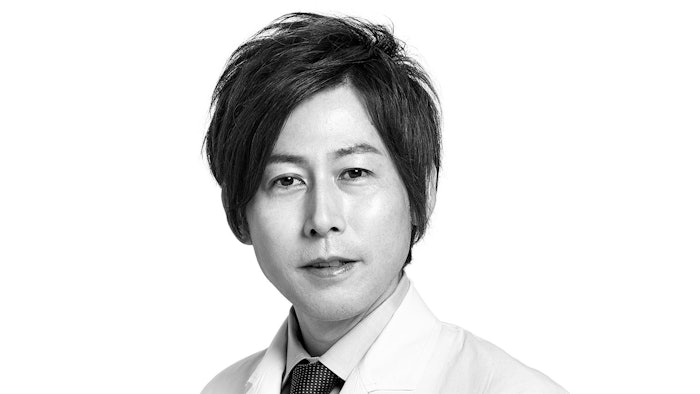
According to Research and Markets, the global market for anti-aging products was estimated at US $34.2 billion in 2020 and is projected to reach a revised $47.8 billion by 2027, growing at a CAGR of 4.9% from 2020 to 2027. Anti-wrinkle products, in particular, are forecasted to record a 5.7% CAGR and reach $19.1 billion; the anti-pigmentation products segment was revised to an adjusted 4.1% CAGR for the next seven-year period.
I expect that the focus will move from morphology-based concerns to less well-defined feelings, such as glowing skin and the volume appearance of skin."
What consumer concerns are driving this growth? And what new directions might anti-aging skin care take? Tomonobu Ezure, Ph.D., principal chief scientist at Shiseido Ltd., shares his insights in this exclusive interview.
What concerns do you see as the most prominent among today's anti-aging product consumers?
I think the age-dependent changes of facial morphology are currently attracting the most interest in the field of anti-aging skin care, and they are probably the greatest concern for consumers right now. One of the earliest targets for skin care was skin dryness, and subsequently the focus changed to wrinkles. Then, as the field developed, the focus switched again to larger aging-related changes of the face, such as sagging, loss of facial contour, nasolabial folds, and so on.
We established definitions and evaluation methods for these changes, and discovered a variety of facial aging key factors, all of which are related to the skin. These discoveries clearly showed that skin itself plays a critical role in facial aging, whereas it had previously been considered that facial aging was due to deeper structures of the face (fat or muscle). Thus, consumers can see that modern skin care products are reasonable as solutions for age-dependent changes of facial morphology, since they are targeting skin.
See archived: Facial Fat as a Key Anti-aging Target
In conjunction, what ingredients or technologies address these product concerns?
The range of cosmetic ingredients has expanded enormously, based on the expansion of aging research in the life sciences as well as regenerative medical treatments. Active ingredients, such as senolytic agents, nicotinamide mononucleotide, stem cell-derived exosomes, and so on, are attracting increasing interest. Since information about anti-aging products and mechanisms is widely available in the media and on the internet, consumers are expecting these products to be included in cosmetics.
How has the trend for minimalistic/simple formulas affected anti-aging product development?
This concept is very important for future cosmetic R&D, since it highlights a critical question about cosmetics. Namely: How do cosmetic products work on the skin? As we know, skin deteriorates with aging, and there are changes of blood vessels, sebaceous glands, sweat glands, and so on, which are supplying water and moisturizing factors to the skin surface. So, for example, application of moisturizing factors on the skin surface is more important for older people than for younger people. Therefore, we can say that the meaning of minimal formula cosmetics is different depending on the consumer’s age, as well as personal characteristics and the season. Therefore, I think that solutions focusing on consumers’ individual skin condition could be the key to next-generation minimal skin care products.
Since anti-aging products impart activities in the skin, how has the market's concern for safe products impacted product development?
The safety of cosmetic products is absolutely critical for manufacturers and consumers, and so the development of novel active ingredients involves extensive and costly safety testing. This has led to increasing interest in traditional active ingredients and natural products with an established safety record. One way to improve their effectiveness is to improve their penetration into the skin by using appropriate formulations, and various methods can be used for this purpose.
What do you see as some of the latest and greatest breakthroughs in anti-aging product development? What novel efficacies are they inspiring, or could they potentially inspire?
The Congress of the International Federation of Societies of Cosmetic Chemists (IFSCC) is the best venue for presenting breakthroughs in skin research. [In fact, Shiseido has] received an unprecedented four successive awards at IFSCC. For example, we developed Digital-3D skin, which [digitally] reconstructed all the internal structures of skin ... (2018), and then 4D-Digital skin, which allowed us to visualize skin dynamics using a supercomputer (2020).
See related: [video] Tomonobu Ezure, Ph.D., on Shiseido's 3D Skin Scanning Tech
By using these technologies, we have clarified the anti-gravity system of the skin, [or] “dynamic belt,” which contributes to prevent sagging caused by deformation of the skin by gravity. I believe this anti-gravity system will be a very important target for a range of new skin care solutions, since the age-dependent change of facial morphology by gravity is one of the hottest topics in current skin care.
Where does anti-aging product development fall short? What are the "unknowns" in biology or chemistry that, if uncovered, could make anti-aging products even better?
Progress in the life science field is explosive, as I just mentioned, and the R&D style of applying cutting-edge research to skin care is common in the cosmetic industry. So, the range of products of this cutting-edge type is overwhelming for consumers. Therefore, I think the trend of R&D will move in two main directions in the future.
One would be the development of a comprehensive, individualized total service based on each person’s skin condition, including the above cutting-edge solutions. To establish this, a systematic range of services would be needed.
The other direction would be solutions tightly focused on skin itself, based on cutting-edge research. These approaches could generate great prestige and brand value for a cosmetics company, based on an original world view of the skin.
What are future directions for anti-aging products?
We’ve seen how the targets of skin care have moved on from the skin surface to a concern with larger changes of facial morphology with aging. In the future, I expect that the focus will move from morphology-based concerns to less well-defined feelings, such as glowing skin and the volume appearance of skin. Of course, these are also classic targets, but it has been difficult to develop fully effective solutions, since it is difficult to find measurable skin parameters to evaluate these feelings. Therefore, I think new measurement technologies are needed to underpin fundamental breakthroughs in skin care R&D. Such technologies would also be useful for providing a science-based service to guide personal care by measuring skin condition.
See related: [video] Cosmetics R&D Vlog: 'Hair-raising' Insights on Anti-aging










